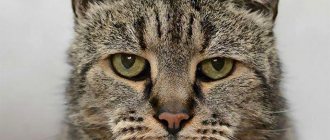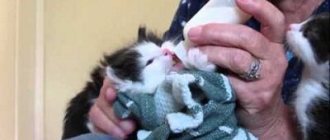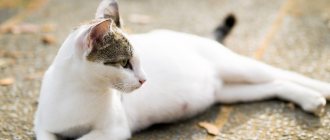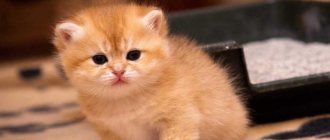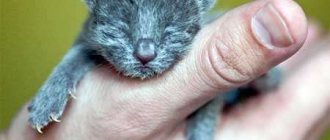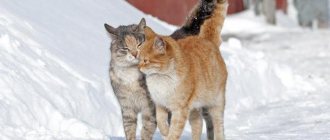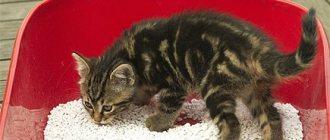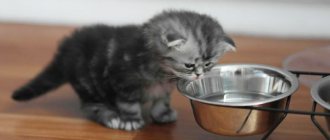Home » Useful Information
- 2 Nurse cat or artificial feeding
- 3 Preparing a place for keeping kittens
- 4 How often to feed kittens
- 5 Cow's milk or formula?
- 6 How to make your own mixtures
- 7 How to properly feed a blind kitten
- 8 How to determine if a kitten is fed enough
- 9 Simple and important care tips
In what cases are newborn blind kittens left without a mother-nurse?
In what cases does the question arise, how to feed newborn kittens without a cat?
Sometimes it happens that a cat dies during childbirth or immediately after it.
It happens that for some reason she refuses to feed her offspring.
And sometimes the soulless owners of their four-legged pet can simply throw the offspring outside so as not to violate their comfort zone.
In any case, orphaned kittens can be saved, even if it is not possible to find a nursing cat and give her sucklings.
A wet nurse is, of course, an ideal option, but such an opportunity is not always available.
Caring for newborn kittens requires patience and some knowledge
The main thing is to properly ensure their maintenance. And this:
- arrangement of a cozy “nest” with heating;
- providing nutrition equivalent to mother's milk;
- proper care for babies, taking into account their physiological needs.
Wool and its care
Even if the baby has learned to lick himself, his fur still requires careful care. Regardless of the breed and length of the coat, it must be accustomed to grooming procedures from a very early age.
When examining the fur, make sure that there are no parasites in it, and also check the skin for redness, scratches and bald spots. For combing, it is better to choose a special comb that will match the length of the coat and is suitable for cats of this breed.
It is necessary to comb a long-haired kitten every day, or at least once every 2 days, to prevent the formation of tangles.
Nurse cat or artificial feeding
When deciding how to feed a newborn kitten without a cat, you need to understand that a wet nurse is the ideal solution for both the smallest kitten and its owner.
As a rule, a nursing cat accepts one or more babies easily.
The main thing is to know that the mother and her kittens are healthy and will not infect the babies with infectious diseases, in particular ear mites .
Important! Colostrum, which a cat feeds its kittens in the first two days, is usually not enough. If your kittens are older than those she is nursing, you will need to continue feeding the babies until the nurse begins to produce enough milk.
General principles of care at 1 month
Before you bring a small kitten into your home, you need to carefully consider the environment and prepare everything you need to make caring for a 1-month-old kitten easier. You should start caring for a small kitten by purchasing the following products:
- Cat litter;
- Bowls for food and drink;
- scratching post;
- Claw clipper;
- Sleeping basket;
- Brushes for combing wool;
- A bag or cage for carrying;
- Toys.
It is important to remember that the sooner you begin to accustom your baby to care procedures, the calmer he will perceive them in the future.
© shutterstock
From the first days of life in your home, your pet must explore the territory and get used to the new environment. If you have a large apartment or a private house, then it is better to start getting used to it in one room, where the baby will be comfortable sleeping, playing or watching others.
After he gets used to it a little, you can offer water or milk, but feed only in a pre-designated place, where, subsequently, he will always have to eat.
Preparing a place for keeping kittens
Under normal conditions, the cat independently provides its babies with the optimal temperature regime.
She warms the little kittens who are with her all the time.
Considering that the physiological norm for a cat’s body temperature is 38 degrees, when arranging a place for babies, it is important to take into account that in the nest it should be a little higher.
An electric or simple heating pad is suitable for heating; an infrared heater is perfect.
You can also use plastic bottles with warm water.
Of course, the water in a simple heating pad or bottle will have to be changed frequently.
But this will not be difficult, because small kittens have to be fed several times a day.
This way it will be easy to control the temperature.
It is best to wrap the bottle in a towel or terry cloth.
It is best to cover the nest with soft, non-synthetic fabric or baby diapers, which, unlike fabric, do not need to be washed.
When choosing between a cardboard box and a basin, it is better to choose a basin: a cardboard box can get wet and absorb odors.
Therefore, keeping small kittens in a basin or plastic box will be more hygienic.
carrying bag is also suitable for this purpose .
Houses for cats will also come in handy , only later: caring for orphaned kittens up to one month of age is not entirely convenient in them.
Toys and other things for development and communication with a kitten
All children love to play, and felines are no exception. Having settled in a new place, the baby begins to enjoy running after a piece of paper on a string or chasing various objects across the floor.
It is better to make sure that the kitten has its own things:
- Movable toys. Fur balls, rubber mice and other similar things. It is important that toys do not have small parts: kittens are teething, the baby can bite off a small part and choke.
- Hanging objects. A ball hanging on a thread on the door handle will occupy the attention of a cat child for a long time.
- Scratching post. Sharpening claws is a natural need of the cat tribe. If you do not acquire this useful item, the furniture or carpet will suffer. In the first days, you need to show your pet a place where it is allowed to sharpen its claws.
A good option would be to purchase a special complex where your pet can climb and jump.
In addition to the fact that the device develops the cat's dexterity and flexibility, purchasing a device will reduce the likelihood that a playful baby will throw flowers from the windowsill or objects from the table.
How often to feed kittens
Month-old kittens can already feed on their own.
But until this time, they will have to pay maximum attention, because they will have to be fed both during the day and at night every two to three hours.
Animals must be handled with extreme caution
The algorithm for feeding small kittens looks like this:
- up to two weeks of age, feeding every two to three hours without a night break;
- in the third and fourth weeks - every two to three hours during the day plus one night feeding;
- from the fifth to the seventh week - every three to four hours during the day, and night feeding is canceled as the babies grow older.
Kitten toilet
Basically, trays are divided into three types:
- Closed trays;
- Open trays with fillers;
- Open trays with grids without fillers.
Closed trays are undoubtedly very convenient for cats, but they are quite expensive and not small in size, so such a tray is not suitable for every city apartment. Open litter trays are preferred by most breeders as they are relatively inexpensive and easy to maintain.
The most budget-friendly option is an open tray with a grid, but in this case one of the owners must always be at home to immediately clean up after the animal.
Cow's milk or formula?
Cow's milk is not the best option for a blind kitten, since its composition is significantly different from the composition of cat's milk.
In addition, it can cause allergies in kittens, resulting in redness of the skin and paws.
The ideal solution is dry mixtures, which can be purchased at veterinary pharmacies.
The mixtures have a balanced composition, which contains all the components necessary for the growing body.
Each package of powdered cat milk replacers Katzenmilch, Royal Canin BabyMilk, Gimpet Cat-Milk, Beaphar Kitty-Milk, Hartz contains a special bottle with a nipple.
Bottles with a nipple are very convenient when feeding kittens
LiveInternetLiveInternet
Your_Veterinarian_Doctor
all posts by the author It’s not such a rare sight in the city - a litter of very small kittens crawling around a garbage dump. Irresponsible fellow citizens thus get rid of unwanted “replenishment” in the family. Orphaned kittens can only count on the mercy of the kind people who found them.
Occasionally, a mother cat dies during childbirth, and even a called veterinarian cannot help (no one is immune from this, even the most experienced breeders of purebred cats). In both cases, orphan kittens require special care so that after a few months they grow into healthy and beautiful animals. If you have newborn kittens in your arms that have lost their mother, try to find a nursing cat. This will be the perfect solution. Without hesitation, you can give a litter of purebred Siamese kittens to the care of your neighbor's tabby Murka - this will not affect the length of the coat, eye color and other characteristics of the breed. Almost always, a nursing cat accepts other people's kittens and takes care of them as if they were her own. If the nurse cat cannot be found, contact your veterinarian. Perhaps he has a cat in mind that recently gave birth. Otherwise, he will advise you on a cat milk replacer, which can be purchased at a veterinary pharmacy.
As a last resort, if there is no nursing cat, but you are lucky enough to find a nursing dog, feel free to give her the kittens! Unlike a cat, not every dog will accept kittens, but if they do, it will be a much better alternative than all kinds of milk substitutes. (site note https://yourvet.ru/) Do not feed kittens cow's milk under any circumstances! It does not contain sufficient proteins and fats necessary for the normal development of kittens. In addition, the milk sugar content of cow's milk is higher than that of cat's milk. This entails digestive disorders and weakened immunity. A kitten may develop rickets if it does not receive enough cat milk or milk substitute within the first six weeks. The cause of rickets is a lack of easily digestible calcium, which is necessary for bone development. Kittens suffering from rickets have a narrow chest and crooked legs, and a weak skeleton. If you have chosen such a kitten, then a cup of cat's milk a day will completely relieve him of the disease, providing him with the necessary amount of calcium. Newborn kittens need to be fed milk every two hours from a bottle with a nipple. The milk should be slightly warmer than room temperature.
(cat's milk replacer) In the third week, it is enough to feed the kittens every three hours, in the fourth - every four hours. Such a stressful feeding routine, when you need to wake up at night, and more than once, is beyond the strength of one person. Therefore, it is better to feed kittens as a family.
(special horns for feeding kittens) The weight gain of a kitten in the first three weeks is 10-15 grams per day. You can use a kitchen scale for weighing. Monitoring the body weight of kittens allows cat sitters to be confident that the babies are getting enough cat milk replacer. Starting from the fifth week, the life of the owners becomes much easier - the kittens can spend the night without feeding. This is the time to introduce kittens to solid food. It’s best to start with special “children’s” canned food. A tablespoon of this food is enough for one feeding. You can add a little water to a portion of canned food and mix well. Canned food should be at room temperature. From the sixth week, the amount of milk can be gradually reduced. At the eighth week, the kitten no longer needs milk. The menu can be varied with a small amount of boiled, finely chopped cow or chicken meat, heart, and liver. Kittens may like boiled fish, cleaned of bones. Try offering your kittens pureed, lightly boiled vegetables - perhaps one of them will turn out to be a vegetarian. The number of meals is gradually reduced as the kitten grows, while the portion size increases depending on appetite. Your kitten's diet should always include fresh drinking water. Cow's milk causes loose stools in kittens. A two-month-old kitten has strong baby teeth and copes well with dry granulated food. Approximate feeding schedule for kittens First and second weeks: feeding milk at 0, 2,4,6, 8,10,12,14,16,18, 20 and 22 hours. Third week: milk feeding at 0, 3, 6, 9, 12, 15, 18 and 21 o'clock. Fourth week: milk feeding at 0, 4, 8, 12, 16 and 20 o'clock. Fifth week: feeding milk at 0 and 14 o'clock, canned food at 8 and 20 o'clock. Sixth and seventh weeks: feeding canned food in the morning, noon and evening, milk as needed (if the kitten does not eat canned food well). Starting from the eighth week: feeding canned food and dry food in the morning and evening. PLACE FOR KITTENS Kittens left without a mother need to create a warm, cozy “house”, which should be placed in a secluded, not too noisy and, most importantly, protected from drafts part of the apartment. There are special incubators for kittens: plastic boxes equipped with an infrared heating lamp. The incubator can be replaced by a rodent cage or a cardboard (plastic) box with high edges. During the cold season, the box can be placed on a radiator or in a warm place, covered with a woolen blanket. Secure the box securely so it doesn't fall over when the kittens start playing with each other. The optimal air temperature for kittens in the first two weeks is +26° C. Later, kittens should gradually be accustomed to room temperature. Kittens of short-haired breeds and Sphynxes are especially sensitive to hypothermia. Place something warm and soft on the bottom of the box (an old woolen pullover is perfect), and a diaper or towel on it, which needs to be changed when it gets dirty. Place soft toys in the box that the kittens will happily snuggle up to instead of their mother. Don’t forget, after wrapping the box with the kittens, to regularly ventilate the room where they are; fresh air is not harmful to them either. I won’t talk about the cleanliness of dishes, bedding, etc., although absolute sterility, apparently, is not necessary. But with purity it is clear: the better, the better. For at least two weeks, babies' main activities are sleeping and eating. Any short-term squeaks and squeals in between feedings are usually associated with the kittens crawling, while they often step on each other - one crawls, everyone screams. But, usually, they quickly calm down. They start yelling if you wake them up - for example, to feed. This is, of course, quite normal. If the screams continue, as it seems to you, for a long time and for no particular reason, check the temperature inside the place where the kittens are; if one of the kittens screams, offer him some food. If he's not eating, it could be because his stomach (bladder) is full, try toileting. And most importantly, remember that now we have much better veterinary care, at least in large cities you can always find a veterinarian in advance, before the birth, and discuss with him all possible complications in the future and ways to solve them. CARE OF KITTENS In the first weeks, the mother cat constantly licks the kittens. So it not only keeps them clean, but also stimulates their digestion, blood circulation and the activity of internal organs. A soft brush or cotton wool soaked in water will completely replace the tongue of a mother cat. After feeding, massage the kitten's tummy in the anus area with damp cotton wool or a brush until it empties. The cat always licks the kittens' tummy after feeding. In addition, once or twice a day, wipe the kitten’s entire body with damp cotton wool, not forgetting the face. Kittens should be toilet trained when they can walk well and eat mostly solid food. Show the kitten the tray and place it there. If you notice that the kitten is rushing around and scratching the floor with its paws, carefully, without putting pressure on its stomach, pick it up and take it to the toilet. Due to their cleanliness, cats quickly get used to the toilet. Little kittens, like children, need peace. At the same time, it is important that orphan kittens feel human love and attention. Starting from the third week of life, kittens can be played with, picked up, stroked and introduced step by step to the world around them. The more you handle kittens in the first weeks of life, the better they will treat you in the future. Your efforts and sleepless nights will be rewarded handsomely: after all, for a grown cat, you will forever remain the beloved and only “mother”.
Source https://forum.bolen-kot.net.ru/index.php?showtopic=5970
How to make your own mixtures
If it is not possible to buy ready-made mixtures, you can prepare them at home yourself.
The main thing is to follow the recipe.
- “Universal” mixture:
- 20% condensed milk diluted 1:5,
- bone meal (1 tsp per 1 liter of milk).
- Mix “Kitten”
- cow's or goat's milk – 25 g
- glucose 5% (20 ml)
- powdered milk – 5 g
- vitamin supplements - 1g.
- “Vitamin” mixture - recommended for weakened and sick kittens
- milk (100 ml)
- glucose 5% (20 ml)
- 1 yolk
- vegetable oil (1/2 teaspoon)
- Tetravit (about 0.3 ml)
- 2 teaspoons of infant formula “Nutrilon fermented milk”.
- “Egg” mixture:
- cow's milk – 200 ml,
- vegetable oil – 1 tsp. spoon,
- egg yolks – 2 pcs.,
- vitamins in drops (tetravit or trivit).
The ingredients of the mixtures must be mixed thoroughly and brought to a homogeneous mass.
Before feeding, the mixture is heated to 38 degrees.
The finished mixture should be stored in the refrigerator for no more than a day.
How to properly feed a blind kitten
To feed a one-week or two-week-old kitten, you need to purchase a pacifier and bottle from a veterinary pharmacy.
An ordinary medical syringe without a needle will also work.
You can use a rubber tip from a pipette, pierced with a hot needle and placed on a small vial.
It is better to feed a kitten up to one month of age from a nipple
Firstly, the sucking instinct is satisfied, and secondly, the risk of aspiration of the respiratory tract with milk or formula is reduced, which can lead to pneumonia.
Feeding from a pipette or syringe requires great care.
Since babies' immunity is still weak, any infection can be fatal.
Important! Cleanliness and sterility of nipples and bottles is an integral rule that must be strictly followed.
While the cub is eating, it is advisable to stroke its head and back and talk to it quietly.
There is no need to limit milk or formula - the suckling's face should be in milk, and the tummy should be rounded.
After feeding, it is advisable to hold the suckling upright.
When the blind kitten is full, he begins to fall asleep, and milk bubbles appear from his mouth.
He needs to wipe his face with a napkin soaked in warm water.
Many people are interested in whether it is possible to determine how much food the baby has received?
It’s possible - well-fed babies calmly fall asleep, but hungry ones get restless, crawl, and squeak.
If you give them a finger, they start sucking it.
Diet of one-month-old kittens
Which diet is better for a one-month-old kitten – dry food or natural food? This is a complex question, and in cat breeder circles there have been serious debates about the benefits of a certain type of feeding for many years.
Of course, if we take as a basis the food in which the manufacturer has included everything that the baby needs for health: vitamins, microelements and other useful additives, then it will be nice if you feed a month-old kitten with just such food. In addition, the owner of the animal is freed from many conventions that appear among people who feed their baby homemade food. And from the point of view of veterinarians, balanced feeding is useful for the full development of the pet. But is dry food suitable for your kitten, and does it contain everything that the manufacturer promises? Yes, maybe you just raised more than one generation of kittens on healthy homemade food, and don’t trust suspicious dry bits. Situations are different, so we will analyze both options, and you will choose which one is right for your kitten yourself. But whatever the outcome, you should remember the basic important rules:
- Let's call the first rule “either-or”. It means that if you start feeding a month-old kitten with natural products, then you do not need to add dry food to its diet. After all, different foods are digested differently. In addition, a kitten consuming dry food drinks much more liquid than a pet eating exclusively natural products. Therefore, if you want to protect your animal from troubles like gastroenteritis, coprostasis and other gastrointestinal troubles, then follow the first rule.
- Next, is it possible to feed a one-month-old kitten different foods? It’s better not. If you have chosen a certain brand of food for your baby, then stick with it. After all, each brand has its own distinctive features and certain components. If food is mixed or changed, then there is a high risk that the kitten will get certain problems associated with calcium levels or, for example, a strange picture of amino acids. Digestive problems are also possible.
- The last basic rule is to buy the right food. There is no need for your child to take a mass-market product. These foods are akin to fast food and all these inexpensive, bright labels will not bring anything good to the baby. Buy premium kitten food, or even better, super-premium. Your pet will definitely be grateful for food of this level.
Natural food
If you want your kitten to be accustomed to natural food, you should adhere to certain conditions:
- The diet should be varied. If you do not accustom your animal to certain foods from an early age, then it will hardly be possible to do this with age. For this reason, try to diversify your baby’s food, offer different things - this will help make the baby an omnivore, will not turn him into a picky creature and will help ensure adequate nutrition.
- Do not feed your pet kibble from your table. First of all, you run a great risk of raising an eternally meowing beggar, and secondly, this can harm the kitten, because human food contains a lot of spices and salt that are harmful to the young body.
What to feed a one-month-old kitten, besides the primary product - milk? You can feed the baby cottage cheese. Only at first it is better to stir it with milk until it reaches a consistency similar to sour cream. Cottage cheese is a good source of calcium, which helps prevent the development of rickets.
The next product is chicken yolk (boiled egg white can be given from 2 months). First, it also needs to be mixed with milk. The following products will also benefit your kitten:
- porridge with meat and milk broth;
- boiled vegetables;
- neutral (no spices) broth soups.
True, not every kitten will enthusiastically attack such food. After all, although it is a month old, it is a predator. Meat products can be any kind. The basic rule is that the meat should not be fatty and any product for the kitten must first be boiled and then chopped. Meat is cooked not for ease of eating, but in order to prevent various diseases and infection of the pet with helminths.
The kitten grows quite rapidly, so its body requires a sufficient amount of minerals and vitamins. By consuming regular food, the baby does not always receive the required amount of nutrients in full. Therefore, it would not be superfluous to add special vitamin complexes to your pet’s food, which can be purchased at any store that sells pet products. There are sufficient quantities of drugs of this kind on the market and you can always choose something for your pet. You can also grow various useful herbs, for example, sprout wheat.
As already mentioned, diversify your diet. It is not advisable to feed the animal only meat or only fish, or even only porridge. By the way, you don’t need to give fish often. It has been proven that frequent consumption of fish leads to inflammatory kidney diseases. And if over time you decide to castrate the animal, then it is better to completely exclude fish from the menu. The kitten's nutrition should be close to natural conditions, this also applies to temperature conditions. Do not give cold (from the freezer) or excessively hot foods. Pet food is not salted.
Remember that the baby must have access to water. This is especially important if the animal eats dry food, because in this case, water consumption increases several times compared to normal conditions. The water should be fresh and clean, change it daily, and rinse the empty bowl with hot water or scald with boiling water.
Ready-made food for one-month-old kittens
Many different brands have gained popularity in the cat food market:
- Hill's Science Plan;
- from Eukanuba Junior Small Breed;
- Royal canin size nutrition mini junior and many others.
Let's look at a few specific examples from the super-premium cat food segment.
- Royal Canin dry food for kittens
You should always remember that the premium class is the best food among the worst representatives of products of this type. And if the prefix “super” is not present on the packaging, this is already a compelling argument to doubt the quality of the food presented. But you still need to be more objective. Let's first talk about the benefits of Royal Canin for kittens:
- affordable pricing policy;
- wide variety of tastes;
- accessibility for the buyer;
- veterinary line.
You can now see the current price of kitten food and buy it right here:
- The next representative is Akana super-premium food for kittens.
Acana offers food in three flavor categories: lamb, chicken, fish.
If we consider the advantages, Akana is characterized by the following positive qualities:
- a balanced diet;
- lack of grain crops in the product;
- no chemical dye.
The main disadvantages are a small variety of tastes and no preventive diets.
- Almo Nature 1 month kitten food is also worthy of mention.
The origins of the popularity of the food lie in triple checking of the quality of the product and the naturalness of the ingredients. In general, Almo Nature food is close in overall quality to VIP class food. Indeed, in this Italian diet, chicken meat (as the basis of the product) and its derivatives occupy 53% of the total weight of the product. Another 14% goes to the share of non-allergenic rice.
The main disadvantage of the presented product is its rather high price.
How to determine if a kitten is fed enough
Advice! Both overfeeding and underfeeding are dangerous for both a week-old and a two-week-old kitten. We need to find a middle ground. Underfed kittens are lethargic or restless and do not gain weight. When overfeeding, problems with stool appear.
The main indicator of overfeeding is stool
If it is liquid and yellowish in color, this means that there is slight overfeeding.
With moderate overfeeding, the stool takes on shades of green.
Constant overfeeding is the cause of gray stools.
If the stool turns white, a veterinarian should be consulted to rule out infection.
How to care for a small kitten
Warmth and massage - this is what newborn kittens need; without a cat, you will have to take care of their little body! First of all, you will need to massage the area under the kitten's tail, imitating the mother's tongue, so that the baby can urinate and have bowel movements.
We look at the baby's chair
The kitten's stool should be golden brown, well formed and fairly firm. Any deviations will indicate overfeeding or underfeeding. Liquid yellow stool is a sign of slight overfeeding. Greenish indicates moderate overfeeding, and gray indicates constant overfeeding of the baby. In case of curdled diarrhea, the baby should be shown to a doctor, as in this case there is a risk of infection.
Definitely warm!
Provide your baby with constant warmth - he needs it vitally. In the first days, heat exchange in kittens has not yet been established, and they spend a lot of energy in order to warm up. In addition, hypothermia is deadly for the kitten, circulatory failure develops, breathing rate decreases, and an irreversible coma occurs.
If a three-day-old kitten is abandoned by a cat, caring for it will be greatly facilitated by an incubator - you can build it yourself. Any box with high sides will do. Place it in a quiet, draft-free place. For heating, use an infrared lamp. It creates even, constant heat at 26°C. Using heating pads or installing electric heaters is dangerous!
The bottom of the incubator should be soft and at the same time elastic, so that the kitten can crawl and not get tangled in rags. In the incubator, one side should be slightly cooler so that the kitten can crawl away and avoid overheating.
